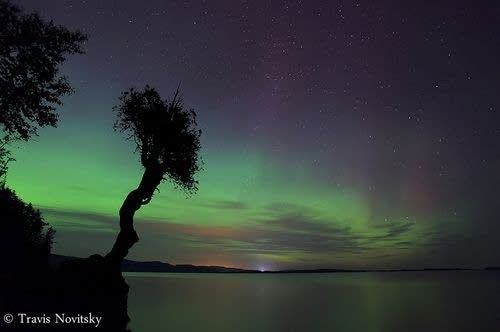Northern lights dazzle Minnesota Tuesday night: Encore tonight?

Forecasting weather here on earth is tough. Forecasting space weather is even tougher, but last night's forecasts of auroras hit the jackpot in parts of Minnesota and Wisconsin.
While haze, humidity and clouds made for iffy viewing in parts of Minnesota last night, conditions were perfect along the North Shore. Reports indicate a vivid northern lights show last night in northern Minnesota and Wisconsin.
Check out the photos Travis Novitsky captured last night between 11pm and midnight near Grand Portage overlooking Lake Superior. You can see the green rays of the aurora dancing in the night sky, as the moon rises over the big lake.
(click imgaes to enlarge)
Create a More Connected Minnesota
MPR News is your trusted resource for the news you need. With your support, MPR News brings accessible, courageous journalism and authentic conversation to everyone - free of paywalls and barriers. Your gift makes a difference.
Here's a link to Travis' excellent aurora gallery.
Anatomy of an aurora:
Northern lights are produced when bursts of solar energy rush through space and interact with the earth's magnetosphere.
Here's the scoop on aurora details from Wikipedia:
Auroras are the result of the emissions of photons in the Earth's upper atmosphere, above 80 km (50 miles), from ionized nitrogen atoms regaining an electron, and oxygen and nitrogen atoms returning from an excited state to ground state. They are ionized or excited by the collision of solar wind particles being funneled down and accelerated along the Earth's magnetic field lines; excitation energy is lost by the emission of a photon of light, or by collision with another atom or molecule:
oxygen emissions
Green or brownish-red, depending on the amount of energy absorbed.
nitrogen emissions
Blue or red. Blue if the atom regains an electron after it has been ionized. Red if returning to ground state from an excited state.
Northern lights captured by the ISS on May 24, 2010.
Better show tonight?
Another burst of solar energy is headed earthward tonight.
Here's the latest update from spaceweather.com.
GEOMAGNETIC STORM--MORE TO COME? The solar storm of August 1st sent two CMEs toward Earth. The first one arrived yesterday, August 3rd, sparking mild but beautiful Northern Lights over Europe and North America. The second CME is still en route. NOAA forecasters estimate a 35% chance of major geomagnetic storms when the cloud arrives on August 4th or 5th. High-latitude sky watchers should remain alert for auroras.
Clear skies less haze and lower humidity may make for an even better show tonight in the Upper Midwest. The best place to view the aurora is away from city lights, in a dark sky or overlooking a lake. Look low toward the northern horizon anytime tonight and you could see a rare treat in the night sky. Best viewing could be anytime, but most likely between 11pm and 3am.
PH